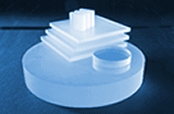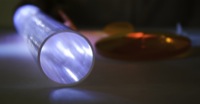
Technology penetrates every sphere of our life making it comfortable and safe, dynamic and fascinating.
When we speak about advanced technologies we should keep it mind that they are based on advanced crystalline materials, invented by humans, conceived by humans, nurtured by humans and shaped by humans.
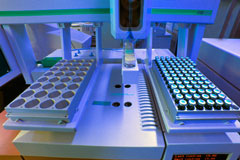
Taking the best traits of a natural crystal and adding the properties they need, people have learnt to produce crystals we cannot imagine our lives without. If you are a fan of Swiss watches you certainly see a synthetic crystal every day, or you rather look through it – the watch face is covered with a synthetic sapphire glass, solid, scratch-proof, smooth and transparent - a perfect complement to the perfect mechanism. This sapphire crystal was produced by a technology which goes back to the beginning of the 20 th century. Over decades crystal growing technologies have been improving and developing and now the use of synthetically produced crystals is no longer confined to watch industry.
If you would like to learn more about different methods of crystal growth please go to our technologies page. And below you will see an overview of industries where various synthetic crystalline materials are used.
- Manufacturing and processing equipment: chemical, vacuum, cryogenic, annealing
- Control and measurement: fire and gas detection, pressure measurement, vibration sensing, exhaust control, temperature measurement, RF control, spectrometry, THz detection
- Thermoelectric devices: thermoelectric generators, Peltier elements
- Optics (light transmission, light reflection, light refraction): UV, visible, IR windows, lenses, mirrors
- Optics (light amplification and light modulation): electro-optical modulators, Pockels cells, wave plates, beam splitters
- Solid-State Lighting: LEDs
- Telecommunications: SAW and BAW filters and resonators
- Medicine: X-Ray tomography, THz tomography, CO2 laser surgery, sapphire scalpels, needles, probes, implants, braces.
- Science: spectrometry, thermal imaging, sample preparation, optical research, chemical experiments.
Manufacturing and processing equipment
Industrial engineering offers a wide choice of applications for our crystals.
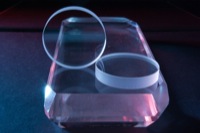 If we take sapphire as an example, equipment manufacturers prefer this material first and foremost for its mechanical properties: its hardness and its unsurpassable ability to withstand high pressure, high temperature and aggressive chemicals. Sapphire tubes, nozzles, rings and other spare parts are often used in high vacuum equipment, cryogenic equipment, gas and plasma delivery systems for chemical etching, chemical processing (surface treatment, chamber cleaning), chemical vapour deposition etc. Sapphire spare parts can operate in various gas media, such as O 2, N 2, H 2O, Ar, NF 3, CF 4, C 2F 6 and other fluorine based gases. Sapphire is also the preferred material for viewports used in kilns for annealing sapphire and ceramics, and in vacuum chambers. A variety of lasers used in industry contain materials you can find on this web site. A good example is CO 2 engravers, which use CVD-ZnSe optics.
Control and measurement
In industry, science and everyday life we often need to scan, identify, detect, measure and control a lot of things, such as moisture, gas, car exhaust, temperature, pressure etc. Due to the variety of technologies and a wide choice of materials used you can find an instrument suitable for a particular application.
- Fire and gas detectors are often based on lead compounds (PbS, PbSe and PbTe).Due to the photoconductive properties these crystals are used for pyrometers, gas monitors, combustion detecting, temperature measurement, automotive exhaust control.
- Pressure and temperature sensors based on silicon-on –sapphire technology show excellent performance in very aggressive media and are often used in oil, petroleum, oceanic industries.

- Langatate crystals are also used for pressure and vibration sensors which can operate at temperatures up to 6000 C
- SAW and BAW filters and resonators based on lanagsite and lithium niobate are used for radio-frequencies control and selection.
- A variety of crystals are used in spectrometry, such as CdWO4 and ZnTe.
- To protect devices which work in harsh environments sapphire parts are commonly used. For example, sapphire windows for fire detection systems. Sapphire is also used to protect thermocouples in temperature measurement (sapphire thermocouple sheaths are also available here). Scratch-proof sapphire windows are often found in industrial and commercial scanners (used for scanning barcodes and banknotes).
- A good example of detection application is the use of THz detectors (with ZnTe crystal) in airport security systems. Terahertz radiation can penetrate fabrics and plastics, so it can be used to uncover concealed objects on a person remotely. It was found that many materials of interest have unique spectral "fingerprints" in the terahertz range. This offers the possibility to combine spectral identification with imaging. Passive detection of Terahertz signatures avoid the bodily privacy concerns of other detection by being targeted to a very specific range of materials and objects
Thermoelectric Devices
- Bi2Te3 is a semiconductor used for manufacturing efficient thermoelectric generators and thermoelectric coolers.
- Thermoelectric generators are indispensable for industries focused on environmentally-friendly solutions, as they actually help to make use of the waste heat by converting it into electric energy. Thermoelectric modules are used in automotive industry (to recover usable energy from automobile waste heat) and in photovoltaics (to recover low frequency radiation energy which is wasted in solar cells).
- Thermoelectric coolers (or Peltier devices) are based on the opposite effect – they use electricity for heat transfer from one end of the device to the other. Peltier elements are used in camping and portable refrigerators, in coolers for digital cameras, computer components, LED modules, lasers, DNA synthesizing thermal cyclers etc.
Optics (light transmission, light reflection, and light refraction)

Synthetic crystals operating in different wavelengths ( sapphire, fused silica, CaF2, ZnSe) are widely used for producing windows, lenses and mirrors in cameras and telescopes. Sapphire optics is mostly used in visible (sometimes in UV and near-IR) range where the instruments are exposed to high pressure or high temperature (instruments for life sciences, environmental research), fused silica is best suitable for UV range, CaF 2 and ZnSe are used in IR optical systems and are mostly used for night vision devices.
Optics (light amplification and light modulation)
- This headline unites optics specially designed to regulate the frequency, phase, polarization and power of a laser beam.
- We have a big choice of crystals that can be used as polarizers, beam splitters, wave plates, electro-optical modulators, e.g. monocrystalline ZnSe, CdSe, GaSe, KDP.
- CdSe and GaSe crystals are often used for differential frequencies generation.
- ZnTe crystal is applied predominantly for THz generation of a solid-state femtosecond laser.
- Non-linear KDP crystals are widely used for generating second, third and fourth harmonics of high-power lasers.
Solid-State Lighting
 Today most countries are focused on green technologies. One of the most prominent trends of this policy is the abolition of incandescent lamps replacing them with energy-efficient compact fluorescent lamp (CFL) bulbs and light emitting diode (LED) bulbs. However, the fact that CFL bulbs contain toxic mercury make them a disputable option for environmental sustainability. At the same time, LED bulbs show lower power consumption (LED lighting can save over 50% of electricity in comparison with conventional lighting), longer life cycle and better luminance efficiency. Many governments are adopting high brightness LEDs for street lighting. LED bulbs are gaining popularity in household lighting, industry lighting, automobile lighting, greenhouse lighting etc. Since 2009 LEDs have been widely used for TV and PC screens backlighting. The brightest and most efficient LEDs are those made of GaN and InGaN deposited on sapphire substrates.
Telecommunications
We refer to this industry segment when we present lanagsite and lithium niobate crystals. These are piezoelectric materials predominantly used for producing SAW and BAW filters, SAW and BAW resonators and other radio frequency devices.
Medicine
In medicine crystals are used either for their mechanical properties to produce medical instruments, or for their semiconductor and optical characteristics to manufacture complicated medical devices.
- X-Ray tomography (CT) often employs the scintillator properties of CdWO4 crystals. Nowadays it is one of the most reliable and most popular methods of medical screening used for detecting tumors in all the organs of the body, haemorrhages, infarctions and bone traumas in head, chronic interstitial processes in lungs, diseases in pulmonary and coronary arteries and abdominal diseases.

- THz ZnTe crystals are used in terahertz tomography.Some experts say that in comparison to X-Ray THz radiation is a less invasive and more effective way in certain areas of diagnostics, e.g. in the detection of epithelial cancer or in 3D imaging in dentistry.
- CO2 lasers with CVD-ZnSe optics were the first lasers used in surgery and they are still the most popular ones. For the past 40 years CO2 lasers have been successfully used in otolaryngology, gynecology, neurosurgery, plastic surgery, dermatology and oral & maxillofacial surgery. The use of a CO2 laser guarantees high precision, minimal tissue damage, little or no bleeding, little swelling and fast recovery.
- The most popular crystal for producing medical instruments is sapphire. Due to its hardness and inertness sapphire is often used for producing endoscope lenses and probes. Sapphire scalpels have a number of advantages over those made of steel, diamond and ceramics. Due to the hardness of sapphire it is possible to achieve a very thin cutting edge - up to 25 nm, which substantially decreases the tissue damage and thus reduces the post-operational rehabilitation period. Sapphire cutting edges have a low friction coefficient, besides, they are more stable, durable and can sustain any type of sterilization without any change in their geometry.
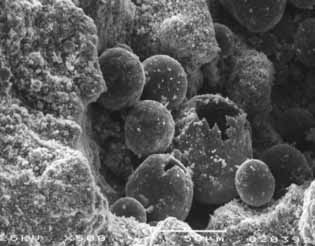 Sapphire scalpels are less expensive than diamond ones and are not limited in size. Unlike ceramic scalpels, sapphire scalpels are optically transparent. This optical transparency reveals a new opportunity for cancer treatment - simultaneous rejection, laser photodynamic impact on the tissues adjacent to the edge and fluorescent diagnostics of the dissected tissue directly during the operation on the malignant tumor. It can be achieved thanks to the special sapphire growing technology which makes it possible to produce scalpels with isolated channels inside. Optical fibers inserted in these channels transmit laser radiation on to the dissected tumor for coagulation and back from the tumor to the spectrometer for the immediate diagnostics. Sapphire scalpels are less expensive than diamond ones and are not limited in size. Unlike ceramic scalpels, sapphire scalpels are optically transparent. This optical transparency reveals a new opportunity for cancer treatment - simultaneous rejection, laser photodynamic impact on the tissues adjacent to the edge and fluorescent diagnostics of the dissected tissue directly during the operation on the malignant tumor. It can be achieved thanks to the special sapphire growing technology which makes it possible to produce scalpels with isolated channels inside. Optical fibers inserted in these channels transmit laser radiation on to the dissected tumor for coagulation and back from the tumor to the spectrometer for the immediate diagnostics.
- A similar principle is put at the basis of using sapphire needle capillaries with a quartz fiber inside for tumor therapy. Sapphire needle capillaries can be as thin as 1.2 mm (with an inner diameter of 0.5 mm). They can be used for photodynamic therapy, laser hyperthermia, voluminous laser coagulation, laser interstitial thermal therapy and
- ablation of malignant tumors.
- Many orthopaedists declare in favour of sapphire implants, for example compound ceramic-sapphire joints implants.
- Sapphire implants are also popular in dental and facial surgery.
- Sapphire braces are the best choice for those people who look for effective, comfortable and invisible orthodontic treatment.
Science
- Spectrometry - X-Ray spectrometry (where CdWO4 crystals are frequently used),
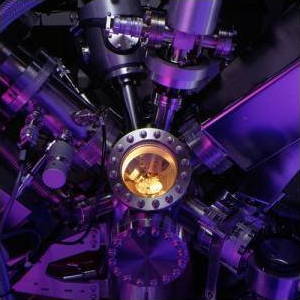 THz spectrometry (base on ZnTe crystals) and IR spectrophotometry (PbS and PbSe) – is a very important method of research in chemistry, biochemistry, astronomy, archeology, physics of high magnetic fields etc. THz spectrometry (base on ZnTe crystals) and IR spectrophotometry (PbS and PbSe) – is a very important method of research in chemistry, biochemistry, astronomy, archeology, physics of high magnetic fields etc.
- Sapphire tubes and probes are often used in analytical chemistry and biochemistry for material research and sample preparation.
- Sapphire tubes and rods are used for light research in UV-visible-near IR spectrum and for experiments with aggressive gas and plasma.
- In environmental research sapphire is used for making windows for deep water camera systems, substrates for deep water pressure and temperature sensors.
- ZnSe, CaF2 and other IR optical materials are often found in thermal imaging cameras used in chemical imaging, volcanology and astronomy.
- Bi2Te3 and Bi2Se3 are widely used in R & D because their application as topological isolators promises incredible opportunities in improving the efficiency of transistors and logical devices.
- NaBi(WO4)2 is an indispensable crystal for elementary particle physics. The crystals are used in Cherenkov detectors.
|






 If we take
If we take 

 Today most countries are focused on green technologies. One of the most prominent trends of this policy is the abolition of incandescent lamps replacing them with energy-efficient compact fluorescent lamp (CFL) bulbs and light emitting diode (LED) bulbs. However, the fact that CFL bulbs contain toxic mercury make them a disputable option for environmental sustainability. At the same time, LED bulbs show lower power consumption (LED lighting can save over 50% of electricity in comparison with conventional lighting), longer life cycle and better luminance efficiency. Many governments are adopting high brightness LEDs for street lighting. LED bulbs are gaining popularity in household lighting, industry lighting, automobile lighting, greenhouse lighting etc. Since 2009 LEDs have been widely used for TV and PC screens backlighting.
Today most countries are focused on green technologies. One of the most prominent trends of this policy is the abolition of incandescent lamps replacing them with energy-efficient compact fluorescent lamp (CFL) bulbs and light emitting diode (LED) bulbs. However, the fact that CFL bulbs contain toxic mercury make them a disputable option for environmental sustainability. At the same time, LED bulbs show lower power consumption (LED lighting can save over 50% of electricity in comparison with conventional lighting), longer life cycle and better luminance efficiency. Many governments are adopting high brightness LEDs for street lighting. LED bulbs are gaining popularity in household lighting, industry lighting, automobile lighting, greenhouse lighting etc. Since 2009 LEDs have been widely used for TV and PC screens backlighting.
 Sapphire scalpels are less expensive than diamond ones and are not limited in size. Unlike ceramic scalpels, sapphire scalpels are optically transparent. This optical transparency reveals a new opportunity for cancer treatment - simultaneous rejection, laser photodynamic impact on the tissues adjacent to the edge and fluorescent diagnostics of the dissected tissue directly during the operation on the malignant tumor. It can be achieved thanks to the special sapphire growing technology which makes it possible to produce scalpels with isolated channels inside. Optical fibers inserted in these channels transmit laser radiation on to the dissected tumor for coagulation and back from the tumor to the spectrometer for the immediate diagnostics.
Sapphire scalpels are less expensive than diamond ones and are not limited in size. Unlike ceramic scalpels, sapphire scalpels are optically transparent. This optical transparency reveals a new opportunity for cancer treatment - simultaneous rejection, laser photodynamic impact on the tissues adjacent to the edge and fluorescent diagnostics of the dissected tissue directly during the operation on the malignant tumor. It can be achieved thanks to the special sapphire growing technology which makes it possible to produce scalpels with isolated channels inside. Optical fibers inserted in these channels transmit laser radiation on to the dissected tumor for coagulation and back from the tumor to the spectrometer for the immediate diagnostics. THz spectrometry (base on ZnTe crystals) and IR spectrophotometry (
THz spectrometry (base on ZnTe crystals) and IR spectrophotometry (
